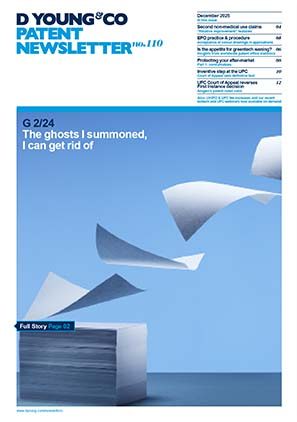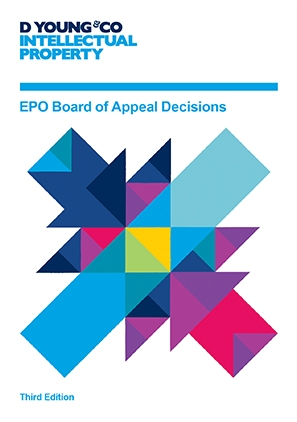Novartis C-354/19: request for CJEU ruling withdrawn
The Swedish Patent and Market Court has recently withdrawn its request for a ruling by the CJEU on the issue of how Article 3(c) of the SPC Regulation (EU Regulation 469/2009/EC) is to be interpreted. The CJEU had been asked to rule on whether Article 3(c) allows a second SPC to be granted based on a second medical use patent where an applicant already has an earlier SPC to the same active ingredient, and where the earlier SPC is based on a basic patent for the product itself.
There are four criteria that an SPC application must meet in order to be granted an SPC in Europe, which are set out in Article 3 of the SPC Regulation. The particular requirement at issue in the present case was Article 3(c) set out below:
“A certificate shall be granted if, in the member state in which the application … is submitted and at the date of that application: …
(c) the product has not already been the subject of a certificate”
Central to the interpretation of Article 3(c) is therefore a consideration of the meaning of the term “product”, and indeed the definition of this term lay at the heart of the Novartis case.
With this in mind, it is noted that Article 1(b) of the SPC Regulation specifies that this term means “the active ingredient or combination of active ingredients of a medicinal product.
Background and facts
The referral to the CJEU was based on an appeal that was filed against the decision of the Swedish Patent Office (PRV) to refuse an SPC application filed by Novartis that was directed to their product, Ilaris®; the product contains canakinumab as the active ingredient.
Ilaris® received its first marketing authorisation in 2009 for the therapeutic indication of Cryopyrin-Associated Periodic Syndrome (CAPS). Novartis subsequently applied for and was granted an SPC for canakinumab based on this marketing authorisation and a basic patent (EP1313769) filed in 2001 which claimed the active ingredient per se.
The second SPC applied for by Novartis was based on a different basic patent (EP1940465) with second medical use claims directed to the use in treating juvenile idiopathic arthritis. This second SPC application was also based on a second marketing authorisation that was received for Ilaris® in which the therapeutic indication was specified as being treatment of this type of arthritis. The expiry date of this second SPC was projected to be almost four years later than the expiry date of the first SPC protecting canakinumab.
The second SPC application was refused by the PRV on the basis that Novartis had previously been granted an SPC for canakinumab and that a new SPC for the same product could therefore not be granted in view of Article 3(c). The first instance Swedish Patent and Market Court upheld the decision of the PRV, commenting that the term “product” had to be interpreted in the strict sense to mean “active ingredient” and that a new therapeutic indication did not constitute a new “product” within the meaning of Article 1(b). The first instance court also commented that the decision in Neurim (C-130/11) was not relevant to the facts of the case since the CJEU in Neurim did not take a position as to how Article 3(c) should be interpreted, noting that the questions referred in Neurim related to Article 3(d); that is, the requirement that the marketing authorisation relied upon be the first authorisation to place the product on the market.
Referral to CJEU
In contrast to the first instance court, however, the referring court (Swedish Patent and Market Court of Appeal) considered that the interpretation of Article 3(c) was unclear. This was largely due to the uncertainty created by the decision of the CJEU in Neurim. For more information on Neurim and the uncertainty this decision created, see our 2012 article ("Sheep don't follow authorisation: CJEU decides on Neurim SPC application") on this decision.
In particular, the referring court commented that the CJEU’s decision in Neurim allowed for the grant of SPCs when a patent protects a new use of a known product, provided that a valid authorisation to place the product on the market as a medicinal product has been granted. The referring court therefore considered that the application of Article 3 as a whole had, in practice, been given a wider purpose of stimulating research into new therapeutic uses of known products, even though a strict interpretation of Article 3(c) would mean that one and the same holder of several basic patents could not be granted more than one SPC for the same product.
The referring court therefore referred a question to the CJEU with the aim of clarifying whether an applicant could be granted a second SPC for a product, where the second SPC concerns a new therapeutic indication which is specifically protected by a new basic patent, and where the applicant already has an earlier SPC to the same active ingredient, the earlier SPC being based on a basic patent for the product itself.
Referral withdrawn – issue under Article 3(c) redundant in view of Santen (C-673/18)?
An order from the CJEU has recently been issued in which it is announced that the request for the referral has been withdrawn by the Swedish Court. This means that the CJEU will not make a ruling on this matter and the previous guidance on interpretation under Article 3(c) will not change. It also means that there are now no more pending referrals to the CJEU on matters relating to SPCs.
It is difficult to be certain why the referral was withdrawn, but one can only infer that the CJEU’s decision in Santen had a big hand to play. As we reported earlier ("Santen (C-673/18): CJEU takes a restrictive view on “first authorisation” for new therapeutic applications"), in Santen, the CJEU held that a strict interpretation of the term “product” must be taken in accordance with Article 1(b). The CJEU therefore rejected the notion that the term “product” can be interpreted broadly to also encompass the way in which the product is used (for example, the therapeutic indication for which the product is authorised). The CJEU’s decision in Santen was thus unequivocal in ruling out the possibility of obtaining an SPC for a new therapeutic application of a previously authorised product.
Therefore, it may well be that Novartis thought the CJEU would go a similar way on Article 3(c) as they did for Article 3(d) in Santen, and they didn’t want an adverse decision on this point. Moreover, it seems inevitable that, even if they had won on the issue of Article 3(c), their SPC application would have been rejected under Article 3(d) in any case based on the decision in Santen.


